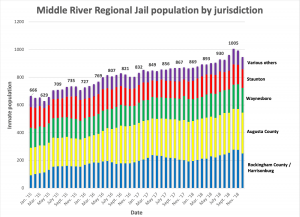
Source: Middle River Regional Jail. Rockingham County and Harrisonburg are listed together because inmates from both localities fall under the supervision of the Rockingham County Sheriff’s Office.
Post by Garrison Ratliff and Zeina Saliba, students in Local Politics and Issue Governance, Fall 2019
On Monday, December 2nd, the Harrisonburg-Rockingham Community Criminal Justice Board held its second meeting of the year. There was an array of topics discussed that gave us insight on the cities’ current criminal justice state, reforms that have been implemented and how the dynamic between the public, the board and representatives from the regional jails plays out. Superintendent Newton spoke on behalf of the Middle River Regional Jail in Augusta county.
He presented to the board the case for expanding Middle River’s facilities as they are currently at over capacity. The jail expanded in 2007, adding two more housing areas with an additional 480 beds. Superintendent Newton explained the three proposal plans that would go into expanding the jail. The first plan was the most extensive with a request to add 400 more beds and 2 new floors for program space. The next two plans were reduced versions of the Plan A, hence cheaper, but considered immediate solutions that overlook future projections based on needs assessments expecting an increase of 1283 individuals to be incarcerated.
Tensions arose between Superintendent Newton and attendees from the audience who questioned the legitimacy of the projections expected by Middle River. Repeatedly asking why the city should expect higher rates of inmates, Newton frustrated, responded that the numerous factors contributing to prison inmate rates is complex and beyond his ability to explain. The Honorable Bruce Albertson added that many inmates are not being transferred from Department of Corrections from regional jails and that the Department of Corrections is not building more jails. Other crucial concerns mentioned was the frustration with inmates who are in regional jails but are ready to be reintroduced to society.
Sheriff Hutcheson presented statistics from Rockingham Regional Jail, some key points noted were the large seizures of meth at 2350 gram, the meth lab busts were supposedly just for personal use while the main import came in from Mexico.
In a separate discussion, Commonwealth Attorney for Rockingham County Marsha Garst, gave an update on the Drug Court’s initiative to combat drug addiction rehabilitation in the criminal justice system. In the drug court, participants who have been screened as high risk and high need plead guilty up front, but sentencing is delayed until after they have completed a drug addiction program. Garst celebrated the program’s success with two new graduates out of 38 current total participants.
We observed a surprising level of disengagement and disinterest among those on the Community Criminal Justice Board of Harrisonburg in regard to public participation. As Superintendent Newton was giving his presentation, questions were asked by members of the board; however, when a citizen raised their hand to pose a question, Newton asked Council Member Christopher Jones, “Are we taking questions from the public?” Jones responded that there would be a portion of the meeting dedicated to public comments and questioning. Although the public turnout was low, the few who attended were well informed and eager to question Superintendent Newton’s claims. Several times attendees asked Superintendent Newton how he could ensure that his projections were legitimate, which required him to repeatedly go over thorough explanations of how Riverside estimated their numbers. His rebuttals were somewhat vague, stating “I was not part of the methodology process, but the agency is a credible and reliable source,” as well as “there are many factors that explain changing numbers in incarcerated individuals.”
There was also a strange attitude observed towards the press. As the Honorable Bruce Albertson was speaking about the criminal justice system and how offenders often times reoffend after their release from incarceration, he stated, “Once we get our hands on them, it’s like a snowball effect.” He then took on a frustrated tone towards offenders saying something along the lines of “it’s like squeezing a tomato.” This comment sparked some disheartened body language among the entire room. Following this comment, Albertson jokingly stated, “I hope the press isn’t here.” After Albertson said this, Council Member Christopher Jones adamantly stated that the press should have been present and that the fact there was no press in attendance was a problem.
Furthermore, public the public comment section of the meeting was incredibly brief and officials displayed negative attitudes towards the public. It felt as though nobody was paying attention to the public comments or taking them seriously. Overall, it appeared that members of the Community Criminal Justice Board were ready for the meeting to come to an end. Christopher Jones even stated that the audience needed to “wrap up” their questioning even though the public questioning period of the meeting was not long by any stretch of the imagination.
We have observed that while there is a certain level of public participation in this Community Criminal Justice Board meeting, officials didn’t fully embrace public participation or media presence. We would argue that the attitude of the appointed members of the board may be a factor in decisions by the public to attend the meetings. The public had virtually no substantial voice and were treated more as an obstacle than a collaborative entity in the meeting. Yet we learned from scholarship in this area that better informed citizens can actively and constructively contribute to decision making on policy issues. This improved information and involvement, in turn, helps to achieve better policy and outcomes, and higher standards of accountability (Wang and Wart, 2007).
Wang, X., & Wart, M. V. (2007). When Public Participation in Administration Leads to Trust: An Empirical Assessment of Managers’ Perceptions. Public Administration Review, 67(2), 265–278. doi: 10.1111/j.1540-6210.2007.00712.x


Recent Comments